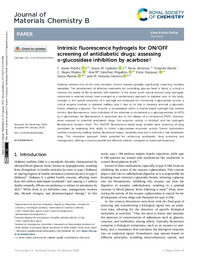Título :
Intrinsic fluorescence hydrogels for ON/OFF screening of antidiabetic drugs: assessing
a-glucosidase inhibition by acarbose† |
Autor :
Patiño, F. Javier
Galindo, Josué M.
Jiménez, Alicia
Alacid Martínez, Yolanda Inmaculada 
Mateo, C. Reyes |
Editor :
The Royal Society of Chemistry |
Departamento:
Departamentos de la UMH::Agroquímica y Medio Ambiente |
Fecha de publicación:
2025-01 |
URI :
https://hdl.handle.net/11000/35671 |
Resumen :
Diabetes remains one of the most prevalent chronic diseases globally, significantly impacting mortality
ratetables. The development of effective treatments for controlling glucose level in blood is critical to
improve the quality of life of patients with diabetes. In this sense, smart optical sensors using hydrogels,
responsive to external stimuli, have emerged as a revolutionary approach to diabetes care. In this study,
changes in the optical properties of a hydrogel are employed for monitoring a-glucosidase activity, a
critical enzyme involved in diabetes mellitus type II due to its role in breaking terminal a-glycosidic
bonds, releasing a-glucose. The enzyme is encapsulated within a triazine-based hydrogel that exhibits
intrinsic blue fluorescence. Upon hydrolysis of the substrate p-nitrophenyl-a-D-glucopyranoside (p-NPG)
by a-glucosidase, the fluorescence is quenched due to the release of p-nitrophenol (PNP). However,
when exposed to potential antidiabetic drugs, the enzyme’s activity is inhibited, and the hydrogel’s
fluorescence remains intact. This ON/OFF fluorescence-based assay enables rapid screening of drug
candidates by evaluating their ability to inhibit a-glucosidase enzymatic activity. Sensor optimization
involves conducting swelling studies, fluorescent assays, reusability tests and a trial with a real antidiabetic
drug. This innovative approach holds potential for enhancing antidiabetic drug screening and
management, offering a more accessible and efficient solution compared to traditional biosensors.
|
Área de conocimiento :
CDU: Ciencias puras y naturales: Química |
Tipo de documento :
info:eu-repo/semantics/article |
Derechos de acceso:
info:eu-repo/semantics/openAccess
Attribution-NonCommercial-NoDerivatives 4.0 Internacional |
DOI :
10.1039/d4tb02466d |
Publicado en:
Journal of Materials Chemistry B |
Aparece en las colecciones:
Artículos Agroquímica y Medio Ambiente
|
 La licencia se describe como: Atribución-NonComercial-NoDerivada 4.0 Internacional.
La licencia se describe como: Atribución-NonComercial-NoDerivada 4.0 Internacional.
.png)
